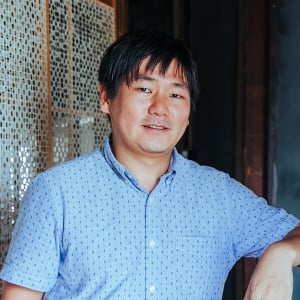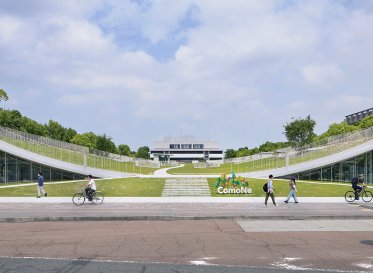
OMRON Corporation Sensing Egg Project
This commercialization of our B2B technology has started
OMRON Corporation’s “OKAO(R) Vision” is top class image sensor technology used in digital cameras and smartphones all over the world. In December 2014, OMRON Corporation decided to distribute the box-type”Human Vision Components – Consumer model (Hereafter HVC-C)” equipped with “OKAO(R) Vision” directly to general developers.
Loftwork Inc. partnered up in order to support creating a space for collaboration with users and developers. And thus, the “Sensing Egg Project” began, a chance to explore new possibilities for products alongside developers. We succeeded in working with the developer community to produce prototypes.
Around two months passed from the start of the project until selling the product. OMRON Corporation’s Yukari Terakawa, Masayoshi Uetsuji, Seiichi Manabe, and Keisuke Hayama reflect on the fast-paced project along with Loftwork Inc.’s Akira Moriuchi and Naoki Kawakami.

Moriuchi(Loftwork) Please tell us about the context of the start of the project.
Terakawa(OMRON) In the spring of 2014, we released “HVC(Human Vision Components)”, originally for corporations. It was an image sensor capable of human detection; it worked simply by attaching it to a device. Even from that time, we considered it something that we would one day commercialize. That thought has now taken shape in the easy-to-use “HVC-C”.
We launched the Sensing Egg Project at the time of development and distribution of the “HVC−C” because we wanted people who would actually use our “OKAO(R) Vision” technology to consider how it could be used in society. However, we weren’t sure of how to proceed. While searching for a partner that would help us in brainstorming and moving forward, we found out about Loftwork Inc. They support many innovative projects and have a network of creators and developers. We consulted with them immediately.

Kawakami(Loftwork) What were some of your expectations of Loftwork Inc. at the time?
Uetsuji(OMRON) Of course, having a network of developers that are close to users. But more importantly, having a partner that would brainstorm with us and tell us when we were making mistakes.
Strategic planning started from a single phrase: ”I want to host a hackathon!”
Terakawa We started developing the “HVC-C” at the end of August. While planning our first meeting, we had to think about how to create our sales strategy while simultaneously continuing development and quickly going through our validation cycle.
Moriuchi And around the end of September, which was when we first made proposals, it was already decided that it would be displayed at CEATEC JAPAN on October 6th. In addition, another product, the “HVC-C1B” would be sold on December 19th. We had a very busy schedule.

Kawakami(Loftwork) At the start of the project, I distinctly remember Ms. Terakawa saying to me, “I want to host a hackathon.” Our aim, however, was not the success of a hackathon. In the end, we put a lot of thinking into working with developers to generate solutions that use the “HVC-C” and making the “OKAO(R) Vision” technology something that could help all over the world.
Moriuchi In order to do it we proposed not holding a single event, but drafting strategies and creative concepts for the first month and holding campaigns, workshops, user meetings, and various programs in the two months leading up to the December release. The idea was to adopt a method which made each process open.
Kawakami We called it the “Sensing Egg Project” with the concept of “raising” sensor technology alongside developers.
Moriuchi We were short on time, but the thing we paid the most attention to was shrinking the gap between developers and OMRON Corporation. We used casual language on sites like Facebook and showed the faces of developers and those in charge of product plannng; we created an atmosphere where OMRON Corporation was supporting developers and building the project together.
We made a developer community and started a campaign to collect prototype applications
Terakawa In reaction to the users’ information and opinions on our website, we were flexible in our upgrades.
Kawakami The very first teaser site was just a hand-drawn illustration. When we started the Facebook page and made the details of the “Sensing Egg Project” clear, we changed the design for developers. We optimize it by repeatedly doing partial upgrades every phase.
Terakawa In general, websites are used for over a year and are hence handled in a more stable manner. Our company knew that the site would be revamped frequently due to my idea to send messages dependent on current conditions during the project.
Moriuchi After launching the website and Facebook page, we started a “Make your own prototype” campaign, where developers would be able to make prototype applications. We aimed to turn these prototypes, which use “HVC‒C”, into actual contents before the official sale date in December. In addition, we aimed to get recognition and increase our presence in the developer community.

The content of our campaign was popular: Use the HVC-C before release date, and get both the beta and official versions of the smartphone apps you develop; all of the applicant spots were filled in an instant.
Kawakami For this campaign, we made full use of our network of developers built up by FabCafe, a place run by Loftwork Inc. We were able to get information about the campaign straight to our target developers through the Fabcafe network.

Moriuchi 194 developers made 75 prototypes with the “Make your own prototype” campaign. I think uploading images of developers making applications which use the HVC-C before release had a large impact.


Seeing the joy of our users firsthand gave us confidence heading into our next developments
Terakawa We held small user meetings where developers gathered; two in Tokyo and one in Kyoto.
Moriuchi Mr. Manabe, a developer at OMRON Corporation, also came to the user meetings. From the eyes of a developer, I figured having an exchange of ideas with a product developer from a manufacturer would be inspirational. In addition, I thought that by making that exchange public via a website or SNS the distance between OMRON Coropration and potential users would change. Sending information online and interacting face to face offline were closely related. By getting our proposal— which combined the benefits of both offline and online interaction— accepted, I think we were able to show the strength of Loftwork Inc.

Uetsuji(OMRON) I joined the project this year, and I was shocked by how close the developers already were with OMRON Corporation. I realized this especially because I joined the project late.
Terakawa Within the company, there were people saying things like “We’re releasing our source code?!” and “For that matter, what the heck is open innovation?”, so I was more happy than anything to hear “This is fun” and “I can probably make something” from people at the workshops and user meetings. Our actions were affirmed, and we were able to confidently start development for our next product.
Manabe(OMRON) I was happy to see someone using a product that I took part in creating. In particular I felt tears in my eyes once I saw an app for those with severe disabilities that could recognize characters on a keyboard from the user’s eye movements. By connecting with many developers, we might be able to provide things to people who really need assistance. It makes me happy as a developer to think that more applications like this could be created.
Moriuchi he phase until now started from zero, so we were able to perceive the project’s results and efficacy mainly through the events and other offline activities. Exchanges with the 20–30 people who gathered at events allowed us to understand that the tens of thousands of people accessing our website have high expectations. I think it is because everyone at OMRON Coroporation understands this that they agreed to constantly changing the website.
Open Innovation created open connections within the company
Moriuchi Through this project , have there been any changes in feedback from within the company?
Terakawa I received an award from the company at the end of last year. Recently we’ve been recognized as “the people doing really interesting stuff”. Sometimes people will approach us and ask, “Can you make something like this?” Our efforts to create an open connection to the outside have produced possibilities for more open connections within the company. In fact, our new team member Mr. Hayama willingly joined us through our internal job application system.

Hayama(OMRON) When I approached Ms. Terakawa with an idea for the HVC-C, she responded with “We’re actually recruiting right now.” I joined without thinking about it too much.(laughs) There are people who need help on the other side of this technology. I’d like to solve their problems together with not only OMRON Corporation, but the developer community as well.
Moriuchi It is because OMRON Corporation has become more open with communication that developers responded with eager interest in just trying to make things. From there developers took action and were able to turn that energy into such a large number of prototypes. That everyone was touched by this fact is the very fuel for the core of open innovation. I will continue to support this project until we reach the final goal of a world where devices that can last with people are made.
Manabe We plan on making firmware updates for the new version of the HVC-C. Once users upgrade they will have access to the latest features; they will be able to use it for a long time.

Terakawa We’re a machine manufacturer, and sometimes just working alone can make one complacent. That is why I would like to work on product development as well as grow the community where we make products together with users. In the future, I’d like to work with the help of Loftwork Inc. again.
Kawakami Thank you very much. I’m looking forward to working together again.
Project Members

Naoki Kawakami
Loftwork Inc.
Senior Director









